Temporal and Spatial Variations in Landscape Habitat Quality under Multiple Land-Use/Land-Cover Scenarios Based on the PLUS-InVEST Model in the Yangtze River Basin, China
Abstract
1. Introduction
2. Materials and Methods
2.1. Study Area and Data Processing
2.2. LUCC Simulation Based on PLUS Model
2.2.1. The Cellular Automata–Markov Model
2.2.2. The Land Expansion Analysis Strategy Module
2.2.3. The Change Analysis, Resilience, and Sustainability Model
2.3. Accuracy Verification of the PLUS Model
2.4. Setting of Future Scenarios
2.5. Habitat Quality Assessment Based on In-VEST Model
3. Results
3.1. Spatiotemporal Analysis of Landscape Pattern
3.2. Accuracy Verification of the PLUS Model
3.3. Multi-Scenario Simulation of LUCC
3.4. Spatiotemporal Analysis of HQ Based on LUCC Change
3.5. Multi-Scenario Simulation of HQ
4. Discussion
4.1. Potential Limitations of This Study
4.2. Driving Mechanism of LUCC Pattern Variation
4.3. Impacts of Landscape Pattern Variation on HQ
4.4. Future Expectations
5. Conclusions
- The area of forest, water, and construction land has increased significantly over the past 20 years in the YRB, that of cropland and unused land has decreased significantly, that of grassland has remained relatively stable, and there have not been significant changes. Construction land is growing at a highly dynamic rate of 47.86% per year, the most significant increase.
- HQ levels have risen, but at a lower level. There has been a gradual decline in the area of HQ at the low and lower levels, with increases in the medium-, high-, and higher-HQ areas. NDS continues the characteristics of historical land-type development. CPS restricts the expansion of construction land and increases the area of arable land by 3.4%. UDS increases the growth of construction land. The implementation of EPS led to a slowdown in the development of construction land, a decrease in the reduction of arable land, and continued growth in grassland. The EPS improved the HQ significantly, while other scenarios increased compared to 2020, but the proportion of high-HQ areas decreased, especially in the CPS and UDS.
- The difference in HQ in different scenarios has an absolute advantage in areas that remain unchanged, with a significant upward trend in EPS and a significant downward trend in UDS.
- Besides national policies, NDVI, temperature, population density, GDP, DEM, and road distance are essential factors influencing landscape patterns. The improvement in HQ is mainly due to the conversion of unused land to grasslands, cropland and waters, and the decline in HQ is due to grassland being turned into unused land.
Author Contributions
Funding
Data Availability Statement
Acknowledgments
Conflicts of Interest
References
- Steffen, W.; Persson, Å.; Deutsch, L.; Zalasiewicz, J.; Williams, M.; Richardson, K.; Crumley, C.; Crutzen, P.; Folke, C.; Gordon, L.; et al. The Anthropocene: From Global Change to Planetary Stewardship. AMBIO 2011, 40, 739–761. [Google Scholar] [CrossRef] [PubMed]
- Deng, Z.; Quan, B. Intensity Characteristics and Multi-Scenario Projection of Land Use and Land Cover Change in Hengyang, China. Int. J. Environ. Res. Public Health 2022, 19, 8491. [Google Scholar] [CrossRef] [PubMed]
- Wang, B.; Cheng, W. Effects of Land Use/Cover on Regional Habitat Quality under Different Geomorphic Types Based on InVEST Model. Remote Sens. 2022, 14, 1279. [Google Scholar] [CrossRef]
- Zhao, G.; Liu, J.; Kuang, W.; Ouyang, Z.; Xie, Z. Disturbance Impacts of Land Use Change on Biodiversity Conservation Priority Areas across China: 1990–2010. J. Geogr. Sci. 2015, 25, 515–529. [Google Scholar] [CrossRef]
- Liu, Y.; Huang, X.; Yang, H.; Zhong, T. Environmental Effects of Land-Use/Cover Change Caused by Urbanization and Policies in Southwest China Karst Area—A Case Study of Guiyang. Habitat Int. 2014, 44, 339–348. [Google Scholar] [CrossRef]
- Krause, A.; Haverd, V.; Poulter, B.; Anthoni, P.; Quesada, B.; Rammig, A.; Arneth, A. Multimodel Analysis of Future Land Use and Climate Change Impacts on Ecosystem Functioning. Earths Future 2019, 7, 833–851. [Google Scholar] [CrossRef]
- Hurtt, G.C.; Chini, L.; Sahajpal, R.; Frolking, S.; Bodirsky, B.L.; Calvin, K.; Doelman, J.C.; Fisk, J.; Fujimori, S.; Klein Goldewijk, K.; et al. Harmonization of Global Land Use Change and Management for the Period 850–2100 (LUH2) for CMIP6. Geosci. Model Dev. 2020, 13, 5425–5464. [Google Scholar] [CrossRef]
- Díaz, S.; Settele, J.; Brondízio, E.S.; Ngo, H.T.; Agard, J.; Arneth, A.; Balvanera, P.; Brauman, K.A.; Butchart, S.H.M.; Chan, K.M.A.; et al. Pervasive Human-Driven Decline of Life on Earth Points to the Need for Transformative Change. Science 2019, 366, eaax3100. [Google Scholar] [CrossRef]
- Wang, Q.; Guan, Q.; Lin, J.; Luo, H.; Tan, Z.; Ma, Y. Simulating Land Use/Land Cover Change in an Arid Region with the Coupling Models. Ecol. Indic. 2021, 122, 107231. [Google Scholar] [CrossRef]
- Peng, J.; Pan, Y.; Liu, Y.; Zhao, H.; Wang, Y. Linking Ecological Degradation Risk to Identify Ecological Security Patterns in a Rapidly Urbanizing Landscape. Habitat Int. 2018, 71, 110–124. [Google Scholar] [CrossRef]
- Wang, Q.; Wang, H. Evaluation for the Spatiotemporal Patterns of Ecological Vulnerability and Habitat Quality: Implications for Supporting Habitat Conservation and Healthy Sustainable Development. Environ. Geochem. Health 2022, 45, 2117–2147. [Google Scholar] [CrossRef] [PubMed]
- Shan, C.; Guo, H.; Dong, Z.; Liu, L.; Lu, D.; Hu, J.; Feng, Y. Study on the River Habitat Quality in Luanhe Based on the Eco-Hydrodynamic Model. Ecol. Indic. 2022, 142, 109262. [Google Scholar] [CrossRef]
- Winchester, N.; White, D. The Climate PoLicy ANalysis (C-PLAN) Model, Version 1.0. Energy Econ. 2022, 108, 105896. [Google Scholar] [CrossRef]
- Hernández-Baz, F.; Romo, H.; González, J.M.; Hernández MD, J.M.; Pastrana, R.G. Maximum Entropy Niche-Based Modeling (Maxent) of Potential Geographical Distribution of Coreura Albicosta (Lepidoptera: Erebidae: Ctenuchina) in Mexico. Fla. Entomol. 2016, 99, 376–380. [Google Scholar] [CrossRef]
- Newbold, T.; Hudson, L.N.; Hill, S.L.L.; Contu, S.; Lysenko, I.; Senior, R.A.; Börger, L.; Bennett, D.J.; Choimes, A.; Collen, B.; et al. Global Effects of Land Use on Local Terrestrial Biodiversity. Nature 2015, 520, 45–50. [Google Scholar] [CrossRef]
- Rahimi, L.; Malekmohammadi, B.; Yavari, A.R. Assessing and Modeling the Impacts of Wetland Land Cover Changes on Water Provision and Habitat Quality Ecosystem Services. Nat. Resour. Res. 2020, 29, 3701–3718. [Google Scholar] [CrossRef]
- Dong, J.; Zhang, Z.; Liu, B.; Zhang, X.; Zhang, W.; Chen, L. Spatiotemporal Variations and Driving Factors of Habitat Quality in the Loess Hilly Area of the Yellow River Basin: A Case Study of Lanzhou City, China. J. Arid. Land 2022, 14, 637–652. [Google Scholar] [CrossRef]
- Xu, L.; Chen, S.S.; Xu, Y.; Li, G.; Su, W. Impacts of Land-Use Change on Habitat Quality during 1985–2015 in the Taihu Lake Basin. Sustainability 2019, 11, 3513. [Google Scholar] [CrossRef]
- Sun, X.; Yu, Y.; Wang, J.; Liu, W. Analysis of the Spatiotemporal Variation in Habitat Quality Based on the InVEST Model- A Case Study of Shangri-La City, Northwest Yunnan, China. J. Phys. Conf. Ser. 2021, 1961, 012016. [Google Scholar] [CrossRef]
- Wei, L.; Zhou, L.; Sun, D.; Yuan, B.; Hu, F. Evaluating the Impact of Urban Expansion on the Habitat Quality and Constructing Ecological Security Patterns: A Case Study of Jiziwan in the Yellow River Basin, China. Ecol. Indic. 2022, 145, 109544. [Google Scholar] [CrossRef]
- Meng, R.; Cai, J.; Xin, H.; Meng, Z.; Dang, X.; Han, Y. Spatio-Temporal Changes in Land Use and Habitat Quality of Hobq Desert along the Yellow River Section. Int. J. Environ. Res. Public Health 2023, 20, 3599. [Google Scholar] [CrossRef]
- Lei, J.; Chen, Y.; Li, L.; Chen, Z.; Chen, X.; Wu, T.; Li, Y. Spatiotemporal Change of Habitat Quality in Hainan Island of China Based on Changes in Land Use. Ecol. Indic. 2022, 145, 109707. [Google Scholar] [CrossRef]
- Sun, X.; Jiang, Z.; Liu, F.; Zhang, D. Monitoring Spatio-Temporal Dynamics of Habitat Quality in Nansihu Lake Basin, Eastern China, from 1980 to 2015. Ecol. Indic. 2019, 102, 716–723. [Google Scholar] [CrossRef]
- Barclay-Smith, P. The World Wildlife Fund. Nature 1962, 193, 12–13. [Google Scholar] [CrossRef]
- Azari, M.; Billa, L.; Chan, A. Multi-Temporal Analysis of Past and Future Land Cover Change in the Highly Urbanized State of Selangor, Malaysia. Ecol. Process. 2022, 11, 2. [Google Scholar] [CrossRef]
- Guo, W.; He, N.; Ban, X.; Wang, H. Multi-Scale Variability of Hydrothermal Regime Based on Wavelet Analysis—The Middle Reaches of the Yangtze River, China. Sci. Total Environ. 2022, 841, 156598. [Google Scholar] [CrossRef]
- Liang, X.; Guan, Q.; Clarke, K.C.; Liu, S.; Wang, B.; Yao, Y. Understanding the Drivers of Sustainable Land Expansion Using a Patch-Generating Land Use Simulation (PLUS) Model: A Case Study in Wuhan, China. Comput. Environ. Urban Syst. 2021, 85, 101569. [Google Scholar] [CrossRef]
- Xu, L.; Liu, X.; Tong, D.; Liu, Z.; Yin, L.; Zheng, W. Forecasting Urban Land Use Change Based on Cellular Automata and the PLUS Model. Land 2022, 11, 652. [Google Scholar] [CrossRef]
- da Cunha, E.R.; Santos, C.A.G.; da Silva, R.M.; Bacani, V.M.; Pott, A. Future Scenarios Based on a CA-Markov Land Use and Land Cover Simulation Model for a Tropical Humid Basin in the Cerrado/Atlantic Forest Ecotone of Brazil. Land Use Policy 2021, 101, 105141. [Google Scholar] [CrossRef]
- Zhang, S.; Yang, P.; Xia, J.; Wang, W.; Cai, W.; Chen, N.; Hu, S.; Luo, X.; Li, J.; Zhan, C. Land Use/Land Cover Prediction and Analysis of the Middle Reaches of the Yangtze River under Different Scenarios. Sci. Total Environ. 2022, 833, 155238. [Google Scholar] [CrossRef] [PubMed]
- Gharaibeh, A.; Shaamala, A.; Obeidat, R.; Al-Kofahi, S. Improving Land-Use Change Modeling by Integrating ANN with Cellular Automata-Markov Chain Model. Heliyon 2020, 6, e05092. [Google Scholar] [CrossRef]
- Xu, C.; Fu, H.; Yang, J.; Wang, L.; Wang, Y. Land-Use-Based Runoff Yield Method to Modify Hydrological Model for Flood Management: A Case in the Basin of Simple Underlying Surface. Sustainability 2022, 14, 10895. [Google Scholar] [CrossRef]
- Shoyama, K.; Braimoh, A.K.; Avtar, R.; Saito, O. Land Transition and Intensity Analysis of Cropland Expansion in Northern Ghana. Environ. Manag. 2018, 62, 892–905. [Google Scholar] [CrossRef]
- Liao, Z.; Zhang, L. Spatio-Temporal Analysis and Simulation of Urban Ecological Resilience in Guangzhou City Based on the FLUS Model. Sci. Rep. 2023, 13, 7400. [Google Scholar] [CrossRef]
- Zhu, K.; Cheng, Y.; Zang, W.; Zhou, Q.; El Archi, Y.; Mousazadeh, H.; Kabil, M.; Csobán, K.; Dávid, L.D. Multiscenario Simulation of Land-Use Change in Hubei Province, China Based on the Markov-FLUS Model. Land 2023, 12, 744. [Google Scholar] [CrossRef]
- Wang, J.; Wu, Y.; Gou, A. Habitat Quality Evolution Characteristics and Multi-Scenario Prediction in Shenzhen Based on PLUS and InVEST Models. Front. Environ. Sci. 2023, 11, 1146347. [Google Scholar] [CrossRef]
- Han, P.; Xiang, J.; Zhao, Q. Spatial Differentiation and Scenario Simulation of Cultivated Land in Mountainous Areas of Western Hubei, China: A PLUS Model. Environ. Sci. Pollut. Res. 2023, 30, 52804–52817. [Google Scholar] [CrossRef]
- Xiao, P.; Zhou, Y.; Li, M.; Xu, J. Spatiotemporal Patterns of Habitat Quality and Its Topographic Gradient Effects of Hubei Province Based on the InVEST Model. Environ. Dev. Sustain. 2023, 25, 6419–6448. [Google Scholar] [CrossRef]
- Jiang, L.; Deng, X.; Seto, K.C. The Impact of Urban Expansion on Agricultural Land Use Intensity in China. Land Use Policy 2013, 35, 33–39. [Google Scholar] [CrossRef]
- Luo, X.; Qin, J.; Cheng, C.; Pan, Y.; Yang, T. Spatial Effects and Influencing Factors of Urban Land Intensive Use in the Yangtze River Delta under High-Quality Development. Front. Environ. Sci. 2022, 10, 1270. [Google Scholar] [CrossRef]
- Yan, T.; Yi Qian, W. Environmental Migration and Sustainable Development in the Upper Reaches of the Yangtze River. Popul. Environ. 2004, 25, 613–636. [Google Scholar] [CrossRef]
- Li, J.; Zhou, K.; Dong, H.; Xie, B. Cultivated Land Change, Driving Forces and Its Impact on Landscape Pattern Changes in the Dongting Lake Basin. Int. J. Environ. Res. Public Health 2020, 17, 7988. [Google Scholar] [CrossRef]
- Xiong, Y.; Zhou, J.; Chen, L.; Jia, B.; Sun, N.; Tian, M.; Hu, G. Land Use Pattern and Vegetation Cover Dynamics in the Three Gorges Reservoir (TGR) Intervening Basin. Water 2020, 12, 2036. [Google Scholar] [CrossRef]
- Yang, L.; Wang, L.; Yu, D.; Yao, R.; Li, C.; He, Q.; Wang, S.; Wang, L. Four Decades of Wetland Changes in Dongting Lake Using Landsat Observations during 1978–2018. J. Hydrol. 2020, 587, 124954. [Google Scholar] [CrossRef]
- Tong, L.; Xu, X.; Fu, Y.; Li, S. Wetland Changes and Their Responses to Climate Change in the “Three-River Headwaters” Region of China since the 1990s. Energies 2014, 7, 2515–2534. [Google Scholar] [CrossRef]
- Yang, H.; Zhong, X.; Deng, S.; Nie, S. Impact of LUCC on Landscape Pattern in the Yangtze River Basin during 2001–2019. Ecol. Inform. 2022, 69, 101631. [Google Scholar] [CrossRef]
- Chen, S.; Wen, Z.; Zhang, S.; Huang, P.; Ma, M.; Zhou, X.; Liao, T.; Wu, S. Effects of Long-Term and Large-Scale Ecology Projects on Forest Dynamics in Yangtze River Basin, China. For. Ecol. Manag. 2021, 496, 119463. [Google Scholar] [CrossRef]
- Cao, Y.; Bai, Z.; Zhou, W.; Wang, J. Forces Driving Changes in Cultivated Land and Management Countermeasures in the Three Gorges Reservoir Area, China. J. Mt. Sci. 2013, 10, 149–162. [Google Scholar] [CrossRef]
- Kong, L.; Zheng, H.; Rao, E.; Xiao, Y.; Ouyang, Z.; Li, C. Evaluating Indirect and Direct Effects of Eco-Restoration Policy on Soil Conservation Service in Yangtze River Basin. Sci. Total Environ. 2018, 631–632, 887–894. [Google Scholar] [CrossRef]
- Zhou, Y.; Li, X.; Liu, Y. Cultivated Land Protection and Rational Use in China. Land Use Policy 2021, 106, 105454. [Google Scholar] [CrossRef]
- Yang, H.; Zhong, X.; Deng, S.; Xu, H. Assessment of the Impact of LUCC on NPP and Its Influencing Factors in the Yangtze River Basin, China. CATENA 2021, 206, 105542. [Google Scholar] [CrossRef]
- Zhang, S.; Jin, C.; Pan, X.; Wei, L.; Shao, H. Coastal Land Use Change and Evaluation of Ecosystem Services Value Enhancement under the Background of Yangtze River Protection: Taking Jiangyin Coastal Areas as an Example. Front. Environ. Sci. 2023, 11, 1088816. [Google Scholar] [CrossRef]
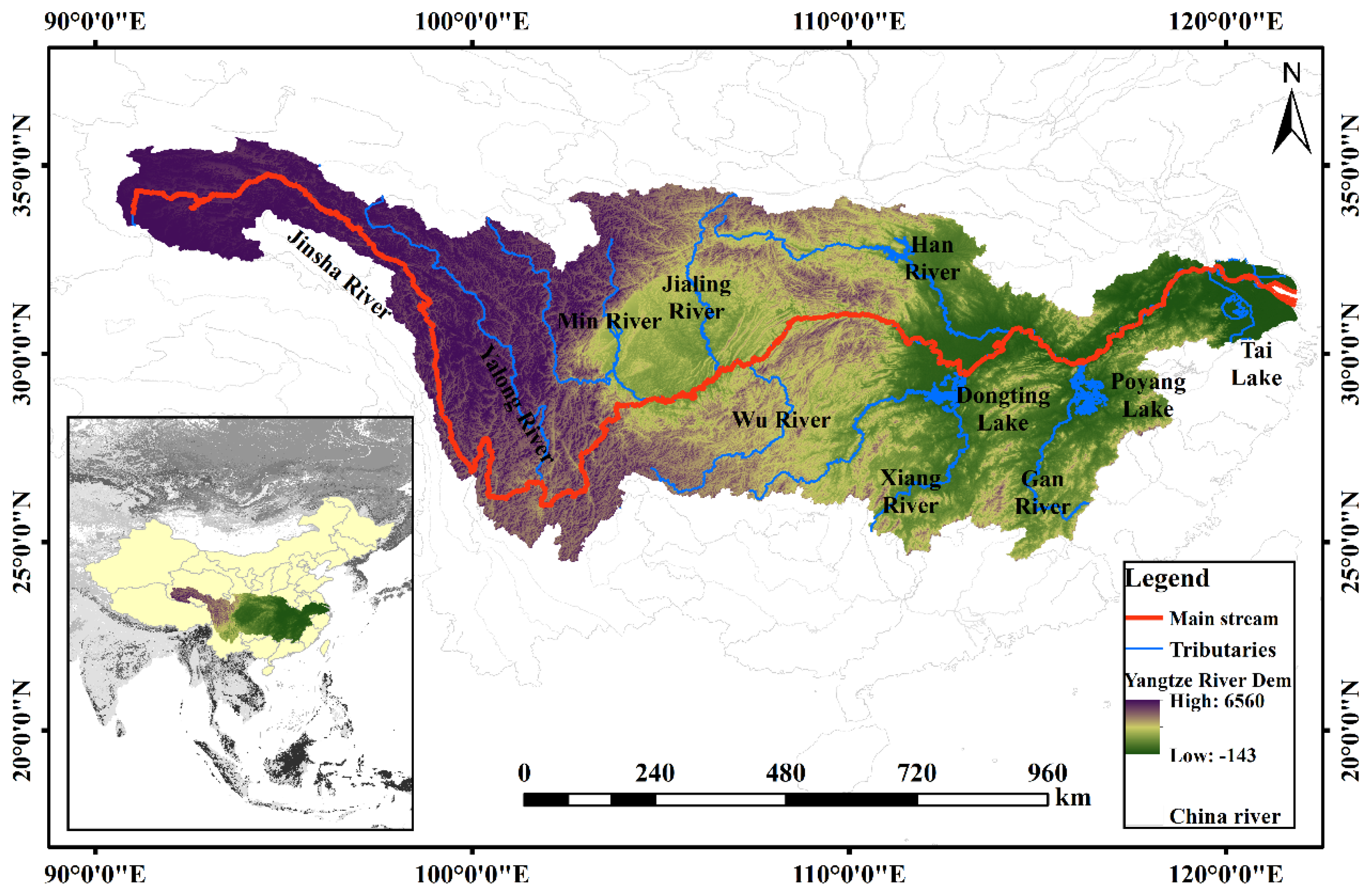
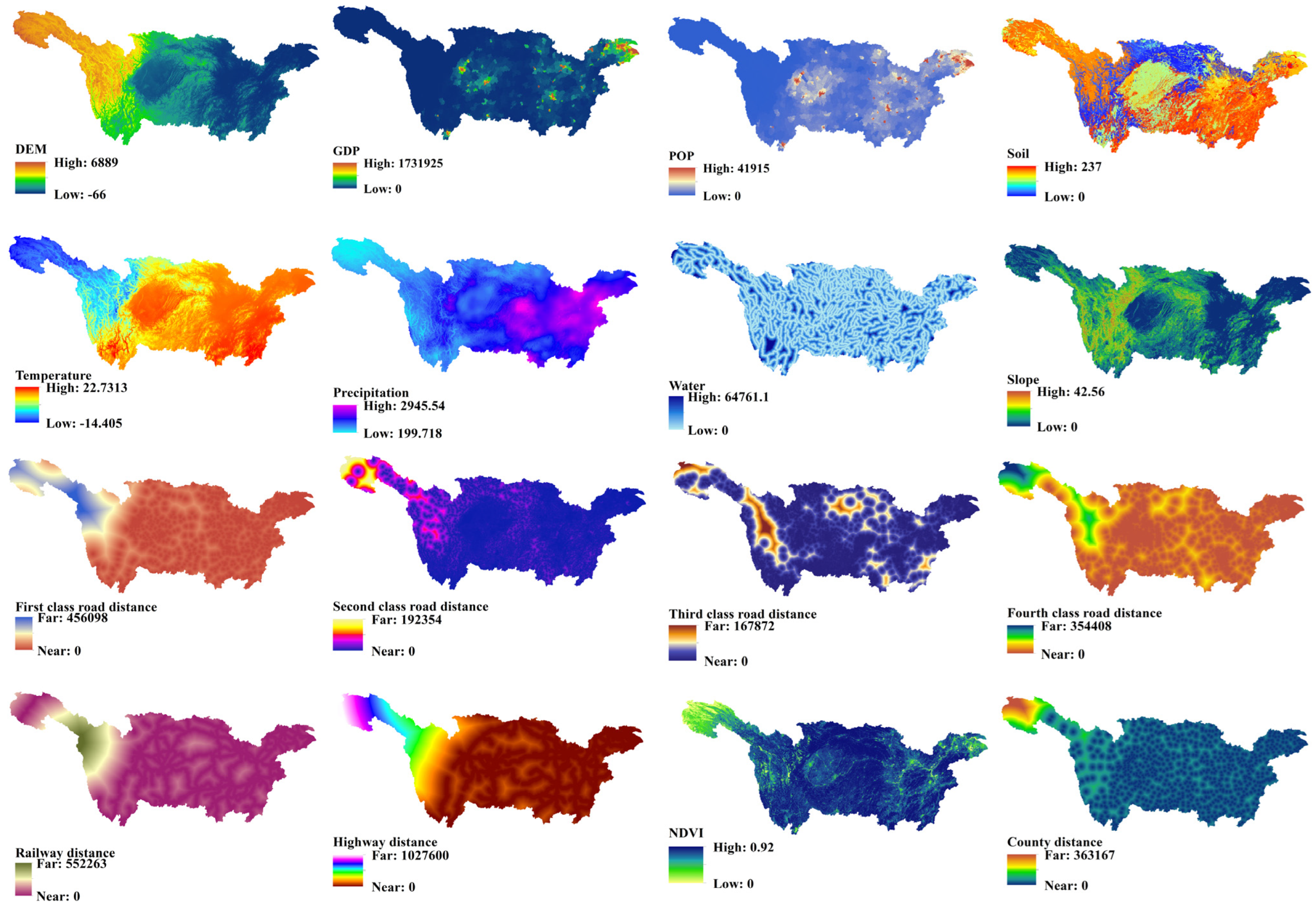
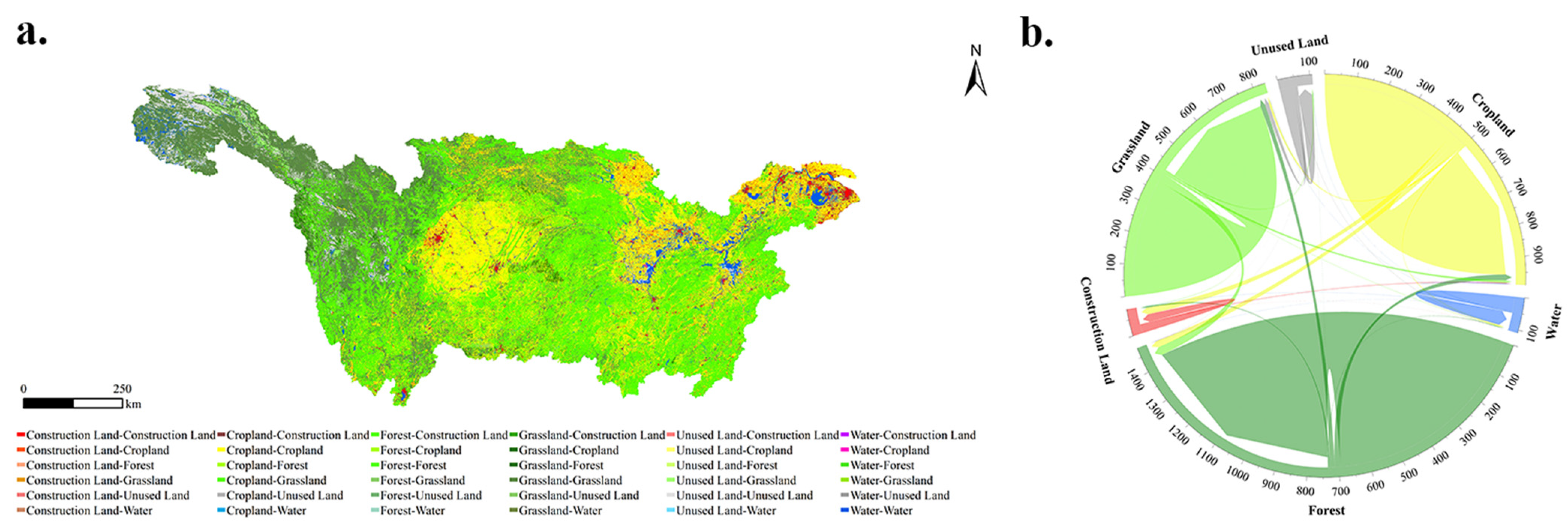
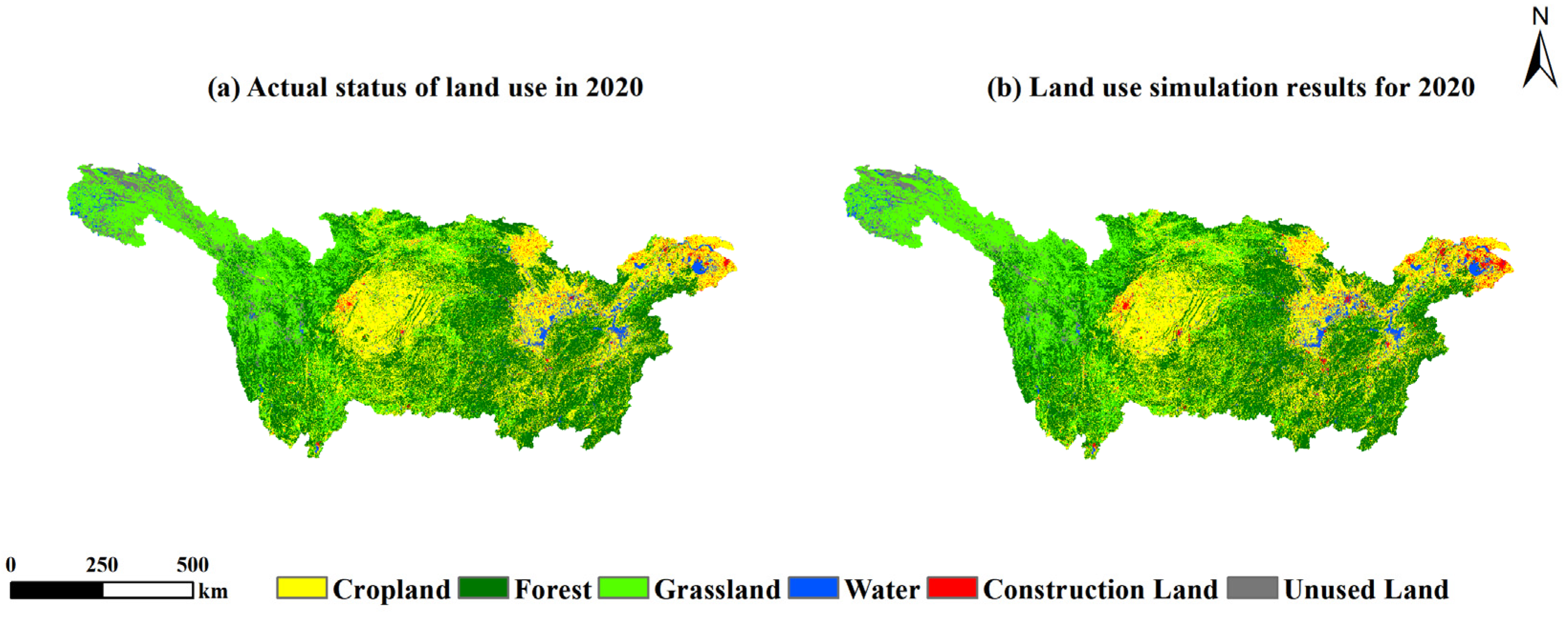

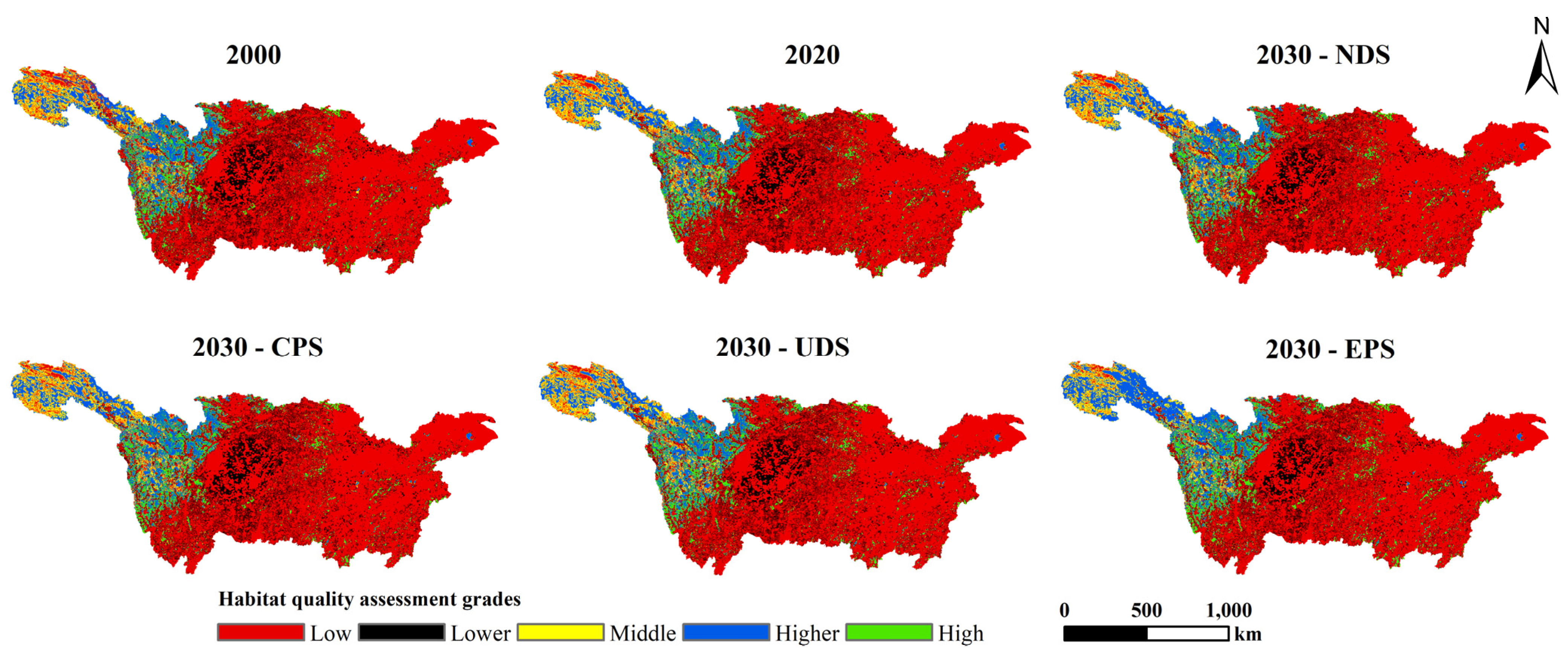
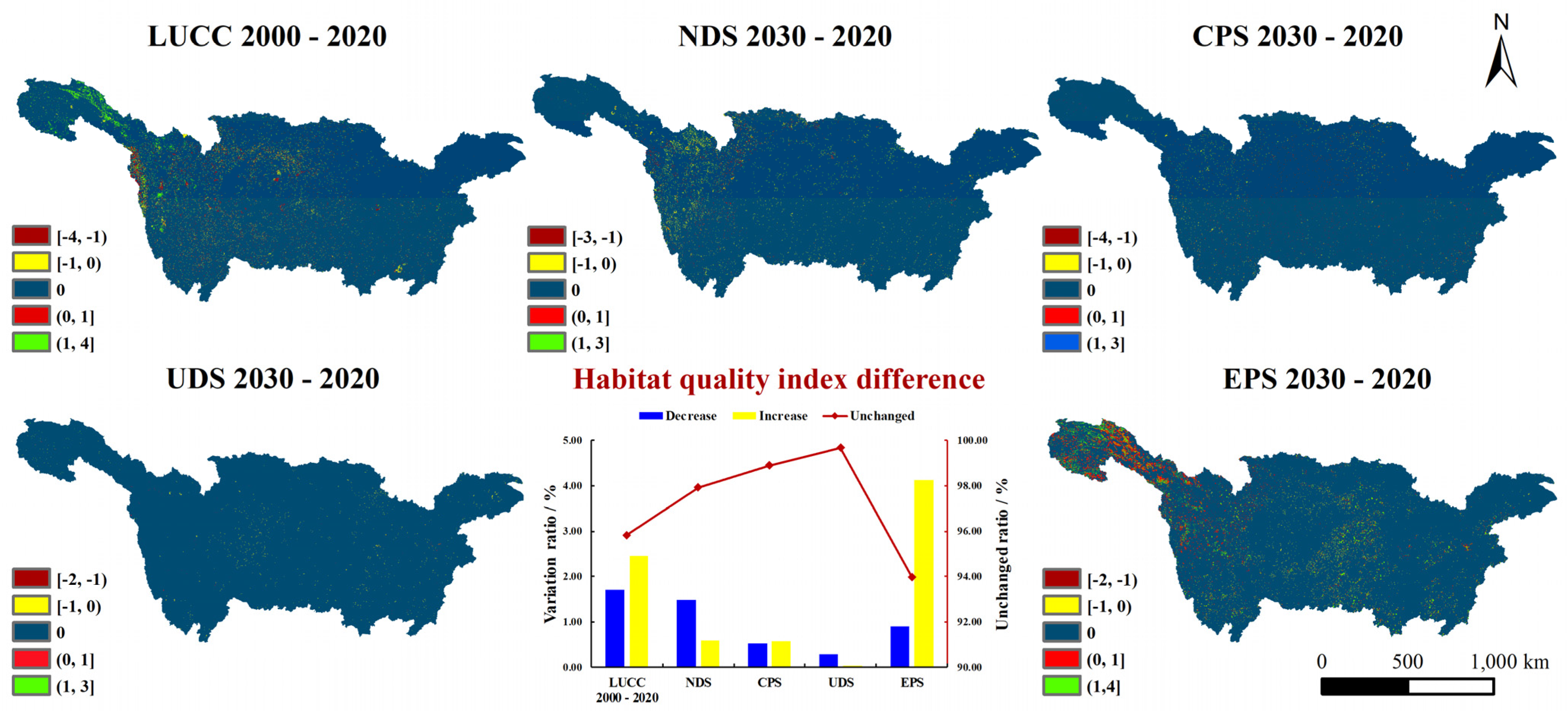

| NDS | CPS | UDS | EPS | |||||||||||||||||||||
|---|---|---|---|---|---|---|---|---|---|---|---|---|---|---|---|---|---|---|---|---|---|---|---|---|
| a | b | c | d | e | f | a | b | c | d | e | f | a | b | c | d | e | f | a | b | c | d | e | f | |
| a | 1 | 0 | 1 | 0 | 1 | 1 | 1 | 0 | 0 | 0 | 0 | 0 | 1 | 0 | 0 | 0 | 1 | 1 | 1 | 1 | 1 | 1 | 1 | 1 |
| b | 0 | 1 | 1 | 0 | 0 | 1 | 1 | 1 | 1 | 0 | 0 | 1 | 1 | 1 | 0 | 0 | 1 | 1 | 0 | 1 | 0 | 0 | 0 | 0 |
| c | 1 | 1 | 1 | 1 | 1 | 1 | 1 | 1 | 1 | 1 | 1 | 1 | 1 | 0 | 1 | 0 | 1 | 0 | 0 | 1 | 1 | 1 | 0 | 0 |
| d | 1 | 0 | 1 | 1 | 0 | 1 | 1 | 0 | 1 | 1 | 0 | 1 | 0 | 1 | 1 | 1 | 1 | 0 | 0 | 0 | 0 | 1 | 0 | 0 |
| e | 0 | 0 | 0 | 0 | 1 | 0 | 0 | 0 | 0 | 0 | 1 | 0 | 0 | 0 | 0 | 0 | 1 | 0 | 0 | 0 | 0 | 0 | 1 | 0 |
| f | 1 | 1 | 1 | 1 | 1 | 1 | 1 | 1 | 1 | 1 | 1 | 1 | 1 | 1 | 1 | 1 | 1 | 1 | 1 | 1 | 1 | 1 | 1 | 1 |
| Habitat | Cropland | Construction Land | Unused Land | |
|---|---|---|---|---|
| Cropland | 0.3 | 0 | 0.6 | 0.1 |
| Forest | 0.9 | 0.8 | 0.6 | 0.2 |
| Grassland | 0.7 | 0.4 | 0.5 | 0.2 |
| Water | 0.75 | 0.7 | 0.8 | 0.2 |
| Project | 2020 | ||||||||
|---|---|---|---|---|---|---|---|---|---|
| Cropland | Forest | Grassland | Water | Construction Land | Unused Land | Total | Rollout Totals | ||
| 2020 | Cropland | 449,616 | 21,465 | 7428 | 4822 | 22,323 | 129 | 505,783 | 56,167 |
| Forest | 19,324 | 693,604 | 16,370 | 1568 | 4244 | 434 | 735,544 | 41,940 | |
| Grassland | 8823 | 28,804 | 378,425 | 1396 | 1323 | 3497 | 422,268 | 43,843 | |
| Water | 2069 | 519 | 619 | 47,895 | 755 | 594 | 52,451 | 4556 | |
| Construction land | 2498 | 322 | 107 | 261 | 26,020 | 18 | 29,226 | 3206 | |
| Unused land | 62 | 593 | 13,189 | 1260 | 31 | 44,135 | 59,270 | 15,135 | |
| Total | 482,392 | 745,307 | 416,138 | 57,202 | 54,696 | 48,807 | 1,804,542 | / | |
| Turn in totals | 32,776 | 51,703 | 37,713 | 9307 | 28,676 | 4672 | / | 164,847 | |
| Actual | Simulation | Simulated Correct Number | Accuracy Rating/% | RMSE | |
|---|---|---|---|---|---|
| Cropland | 505,375 | 490,847 | 467,442 | 95.23 | 0.1662 |
| Forest | 733,940 | 750,593 | 736,843 | 98.17 | 0.1745 |
| Grassland | 420,480 | 411,067 | 398,320 | 96.90 | 0.1468 |
| Water | 52,340 | 50,500 | 49,125 | 97.28 | 0.0682 |
| Construction Land | 29,072 | 45,920 | 41,956 | 91.37 | 0.0632 |
| Unused land | 59,145 | 59,222 | 49,513 | 83.61 | 0.0539 |
| Cropland | Forest | Grassland | Water | Construction Land | Unused Land | Total | |
|---|---|---|---|---|---|---|---|
| Cropland | −0.0016 | −2.1432 | −1.1548 | −1.1263 | −0.1682 | −0.0353 | −4.6293 |
| Forest | 2.0919 | 0.1089 | 0.1261 | −0.2148 | −0.0904 | −11.4579 | −9.4361 |
| Grassland | 3.6591 | 1.0434 | 0.6576 | 1.4815 | −0.2393 | −12.6144 | −6.0121 |
| Water | 1.0007 | −0.0149 | 1.6975 | 0.1418 | −0.1716 | −10.7005 | −8.0469 |
| Construction Land | 0.6257 | −0.4990 | 7.6254 | −0.3885 | −0.0284 | −0.2517 | 7.0836 |
| Unused Land | 3.0873 | 26.3509 | 31.0341 | 12.6929 | −0.0792 | 0.8028 | 73.8887 |
| Total | 10.4633 | 24.8461 | 39.9859 | 12.5866 | −0.7770 | −34.2570 | 52.8479 |
Disclaimer/Publisher’s Note: The statements, opinions and data contained in all publications are solely those of the individual author(s) and contributor(s) and not of MDPI and/or the editor(s). MDPI and/or the editor(s) disclaim responsibility for any injury to people or property resulting from any ideas, methods, instructions or products referred to in the content. |
© 2023 by the authors. Licensee MDPI, Basel, Switzerland. This article is an open access article distributed under the terms and conditions of the Creative Commons Attribution (CC BY) license (https://creativecommons.org/licenses/by/4.0/).
Share and Cite
He, N.; Guo, W.; Wang, H.; Yu, L.; Cheng, S.; Huang, L.; Jiao, X.; Chen, W.; Zhou, H. Temporal and Spatial Variations in Landscape Habitat Quality under Multiple Land-Use/Land-Cover Scenarios Based on the PLUS-InVEST Model in the Yangtze River Basin, China. Land 2023, 12, 1338. https://doi.org/10.3390/land12071338
He N, Guo W, Wang H, Yu L, Cheng S, Huang L, Jiao X, Chen W, Zhou H. Temporal and Spatial Variations in Landscape Habitat Quality under Multiple Land-Use/Land-Cover Scenarios Based on the PLUS-InVEST Model in the Yangtze River Basin, China. Land. 2023; 12(7):1338. https://doi.org/10.3390/land12071338
Chicago/Turabian StyleHe, Ning, Wenxian Guo, Hongxiang Wang, Long Yu, Siyuan Cheng, Lintong Huang, Xuyang Jiao, Wenxiong Chen, and Haotong Zhou. 2023. "Temporal and Spatial Variations in Landscape Habitat Quality under Multiple Land-Use/Land-Cover Scenarios Based on the PLUS-InVEST Model in the Yangtze River Basin, China" Land 12, no. 7: 1338. https://doi.org/10.3390/land12071338
APA StyleHe, N., Guo, W., Wang, H., Yu, L., Cheng, S., Huang, L., Jiao, X., Chen, W., & Zhou, H. (2023). Temporal and Spatial Variations in Landscape Habitat Quality under Multiple Land-Use/Land-Cover Scenarios Based on the PLUS-InVEST Model in the Yangtze River Basin, China. Land, 12(7), 1338. https://doi.org/10.3390/land12071338








